Cost-Optimal Analysis for Nearly Zero Energy Buildings Design and Optimization: A Critical Review
Abstract
:1. Introduction
2. Cost-Optimal Analysis
2.1. The Defined Multi-Step Approach
- macroeconomic perspective (societal level);
- microeconomic perspective (private/end-users or financial level)
2.2. Global Cost Method
- CG(τ) is the global cost referred to starting year τ0;
- CI is the sum of initial investment costs;
- Ca,i(j) is the annual cost for component j at the year i;
- Rd(i) is the discount rate for year I;
- Vf,τ(j) is the final value of component j at the end of the calculation period.
2.3. First Experiences in COA Applications: References and Highlights
3. Cost-Optimality and Research at a Glance
4. Comparing Methods: Building Energy Performance Assessment and EEM Selection
4.1. Simplified Energy Performance Assessment with Manual Selection of EEMs (S-M)
4.2. Dynamic Energy Simulation with Manual Selection of the EEMs (D-M)
4.3. Simplified Energy Performance Assessment with Automated Selection of the EEMs (S-A)
4.4. Dynamic Energy Simulation with Automated Selection of the EEMs (D-A)
4.5. Type and Number of Selected EEMs
5. Comparing Cost Calculation: Financial Assumptions
6. Comparing Results: Cost-Optimal Levels and Optimal EEMs
6.1. Global Cost Values and Gaps
6.2. Resulting Optimal EEMs
6.2.1. Cost-Optimal EEMs Related to the Energy System and RES
6.2.2. EEMs Related to the Building Envelope
7. Beyond the Classical Cost-Optimal Analysis: Considering Uncertainty and Future Scenarios
8. Conclusions
Author Contributions
Acknowledgments
Conflicts of Interest
References
- EPBD Recast: Directive 2010/31/EU of the European Parliament and of Council of 19 May 2010 on the energy performance of buildings (recast). Off. J. Eur. Union 2010, 153, 13–35.
- Building Performance Institute Europe (BPIE). Europe’s Buildings under the Microscope. A Country-By-Country Review of the Energy Performance of Buildings; BPIE: Brussels, Belgium, 2011. [Google Scholar]
- Commission Delegated Regulation (EU) No 244/2012 of 16 January 2012 supplementing Directive 2010/31/EU of the European Parliament and of the Council on the energy performance of buildings by establishing a comparative methodology framework for calculating cost-optimal levels of minimum energy performance requirements for buildings and building elements. Off. J. Eur. Union 2012, 136, 18–36.
- Gustavsson, L.; Joelsson, A. Life cycle primary energy analysis of residential buildings. Energy Build. 2010, 42, 210–220. [Google Scholar] [CrossRef]
- Azari, R. Integrated energy and environmental life cycle assessment of office building envelopes. Energy Build. 2014, 82, 156–162. [Google Scholar] [CrossRef]
- Verbeeck, G.; Hens, H. Life cycle inventory of buildings: A calculation method. Build. Environ. 2010, 45, 1037–1041. [Google Scholar] [CrossRef]
- Dolmens, D. A Change is going to come. A New Mandate: Nearly zero energy buildings. REHVA Eur. HVAC J. 2011, 48, 34–38. [Google Scholar]
- Guidelines accompanying Commission Delegated Regulation (EU) No 244/2012 of 16 January 2012 supplementing Directive 2010/31/EU of the European Parliament and of the Council on the energy performance of buildings by establishing a comparative methodology framework for calculating cost-optimal levels of minimum energy performance requirements for buildings and building elements. Off. J. Eur. Union 2012, 115, 2–26.
- Kurnitski, J.; Saari, A.; Kalamees, T.; Vuolle, M.; Niemelä, J.; Tark, T. Cost-optimal and nearly zero (nZEB) energy performance calculations for residential buildings with REHVA definition for nZEB national implementation. Energy Build. 2011, 43, 3279–3288. [Google Scholar] [CrossRef]
- Pikas, E.; Thalfeldt, M.; Kurnitski, J. Cost-optimal and nearly zero energy building solutions for office buildings. Energy Build. 2014, 74, 30–42. [Google Scholar] [CrossRef]
- Ganiç, N.; Yılmaz, A.Z. Adaptation of the cost-optimal level calculation method of Directive 2010/31/EU considering the influence of Turkish national factors. Appl. Energy 2014, 123, 94–107. [Google Scholar] [CrossRef]
- Barthelmes, V.M.; Becchio, C.; Bottero, M.C.; Corgnati, S.P. The Influence of Energy Targets and Economic Concerns in Design Strategies for a Residential Nearly-Zero Energy Building. Buildings 2014, 4, 937–962. [Google Scholar] [CrossRef]
- Hamdy, M.; Hasan, A.; Siren, K. A multi-stage optimization method for cost-optimal and nearly-zero-energy building solutions in line with the EPBD-recast 2010. Energy Build. 2013, 56, 189–203. [Google Scholar] [CrossRef]
- Corrado, V.; Ballarini, I.; Paduos, S. Assessment of Cost-optimal Energy Performance Requirements for the Italian Residential Building Stock. Energy Procedia 2014, 45, 443–452. [Google Scholar] [CrossRef]
- Ascione, F.; Bianco, N.; De Stasio, C.; Mauro, G.M.; Vanoli, G.P. A new methodology for cost-optimal analysis by means of the multi-objective optimization of building energy performance. Energy Build. 2015, 88, 78–90. [Google Scholar] [CrossRef]
- Ferrara, M.; Fabrizio, E.; Virgone, J.; Filippi, M. A simulation-based optimization method for cost-optimal analysis of nearly Zero Energy Buildings. Energy Build. 2014, 84, 442–457. [Google Scholar] [CrossRef]
- Becchio, C.; Dabbene, P.; Fabrizio, E.; Monetti, V.; Filippi, M. Cost-optimality assessment of a single family house: Building and technical systems solutions for the nZEB target. Energy Build. 2015, 90, 173–187. [Google Scholar] [CrossRef]
- Monetti, V. Scalable Dynamic Simulation-Based Methodology for the Energy Retrofit of Existing Buildings. Ph.D. Thesis, Politecnico di Torino, Turin, Italy, 2015. [Google Scholar]
- Becchio, C. Assessment of Energy and Cost Effectiveness in Retrofitting Existing Buildings. Ph.D. Thesis, Politecnico di Torino, Turin, Italy, 2013. [Google Scholar]
- Building Performance Institute Europe (BPIE). Cost-Optimality. Discussing Methodology and Challenges within the Recast Energy Performance of Buildings Directive; BPIE: Brussels, Belgium, 2010. [Google Scholar]
- Building Performance Institute Europe (BPIE). Implementing the Cost-Optimal Methodology in EU Countries. Lessons Learned from Three Case Studies; BPIE: Brussels, Belgium, 2013. [Google Scholar]
- Boermans, T.; Bettgenhauser, K.; Hermelink, A.; Schimschar, S. Cost-optimal Building Performance Requirements; European Council for an Energy Efficient Economy: Stockholm, Sweden, 2011. [Google Scholar]
- Corrado, V.; Ballarini, I.; Paduos, S. Sviluppo Della Metodologia Comparativa Cost-Optimal Secondo Direttiva 2010/31/UE; ENEA: Rome, Italy, 2013. [Google Scholar]
- Fokaides, P.A.; Papadopoulos, A.M. Cost-optimal insulation thickness in dry and mesothermal climates: Existing models and their improvement. Energy Build. 2014, 68, 203–212. [Google Scholar] [CrossRef]
- Teodoriu, G.; Balan, M.; Şerbănoiu, I.; Verdeş, M. Cost-optimal Analysis of Performance Relation Thermal Insulation—Hydronic Heating System Applied to Romanian Residential Buildings. Procedia Technol. 2014, 12, 583–590. [Google Scholar] [CrossRef]
- Brandão de Vasconcelos, A.; Cabaço, A.; Pinheiro, M.D.; Manso, A. The impact of building orientation and discount rates on a Portuguese reference building refurbishment decision. Energy Policy 2016, 91, 329–340. [Google Scholar] [CrossRef]
- Hamdy, M.; Nguyen, A.-T.; Hensen, J.L.M. A performance comparison of multi-objective optimization algorithms for solving nearly-zero-energy-building design problems. Energy Build. 2016, 121, 57–71. [Google Scholar] [CrossRef] [Green Version]
- Ferrara, M.; Fabrizio, E.; Virgone, J.; Filippi, M. Energy systems in cost-optimized design of nearly zero-energy buildings. Autom. Constr. 2016, 70, 109–127. [Google Scholar] [CrossRef]
- Corgnati, S.P.; Fabrizio, E.; Filippi, M.; Monetti, V. Reference buildings for cost-optimal analysis: Method of definition and application. Appl. Energy 2013, 102, 983–993. [Google Scholar] [CrossRef]
- European Committee for Standardization (CEN). European Committee for Standardization CEN/TR 15615: Explanation of the General Relationship between Various European Standards and the Energy Performance of Building Directive (EBPD); Umbrella Document; CEN: Tallinn, Estonia, 2008. [Google Scholar]
- European Committee for Standardization (CEN). ISO 13790, Energy Performance of Buildings, Calculation of Energy Use for Space Heating and Cooling; CEN: Tallinn, Estonia, 2008. [Google Scholar]
- European Committee for Standardization (CEN). EN 15459, Energy Performance of Buildings. Economic Evaluation Procedure for Energy Systems in Buildings; CEN: Tallinn, Estonia, 2007. [Google Scholar]
- Hasan, A. Selection of Optimal Combinations of Measures for Energy-Refurbishment of Buildings. REHVA Eur. HVAC J. 2010, 48–53. [Google Scholar]
- Hamdy, M.; Palonen, M.; Hasan, A. Implementation of Pareto-Archive NSGA-II Algorithms to a Nearly-Zero-Energy Building Optimisation Problem. In Proceedings of the First Building Simulation and Optimization Conference, Loughborough, UK, 10–11 September 2012. [Google Scholar]
- Kapsalaki, M.; Leal, V.; Santamouris, M. A methodology for economic efficient design of Net Zero Energy Buildings. Energy Build. 2012, 55, 765–778. [Google Scholar] [CrossRef]
- Kwiatkowski, J.; Panek, A.; Lehmden, A.; Unger, C. Consideration about the Cost-optimal Methodology to Determine Energy Performance Requirements for Buildings. In Proceedings of the Central Europe towards Sustainable Building 2013, Prague, Czech Republic, 26–28 June 2013. [Google Scholar]
- Oliveira Panão, M.J.N.; Rebelo, M.P.; Camelo, S.M.L. How low should be the energy required by a nearly Zero-Energy Building? The load/generation energy balance of Mediterranean housing. Energy Build. 2013, 61, 161–171. [Google Scholar] [CrossRef] [Green Version]
- Thalfeldt, M.; Pikas, E.; Kurnitski, J.; Voll, H. Facade design principles for nearly zero energy buildings in a cold climate. Energy Build. 2013, 67, 309–321. [Google Scholar] [CrossRef]
- Arumägi, E.; Kalamees, T. Analysis of energy economic renovation for historic wooden apartment buildings in cold climates. Appl. Energy 2014, 115, 540–548. [Google Scholar] [CrossRef]
- Aste, N.; Adhikari, R.S.; Manfren, M. Cost-optimal analysis of heat pump technology adoption in residential reference buildings. Renew. Energy 2013, 60, 615–624. [Google Scholar] [CrossRef]
- Becchio, C.; Corgnati, S.P.; Fabrizio, E.; Ganiç, N.; Monetti, V.; Zerrin Yilmaz, A. Application of the cost-optimal methodology to two European case studies: An Italian and a Turkish retrofitted existing office building. In Historical and Existing Buildings: Designing the Retrofit. An Overview from Energy Performances to Indoor Air Quality; AICARR: Milano, Italy, 2014; pp. 427–441. [Google Scholar]
- De Angelis, E.; Pansa, G.; Serra, E. Research of Economic Sustainability of Different Energy Refurbishment Strategies for an Apartment Block Building. Energy Procedia 2014, 48, 1449–1458. [Google Scholar] [CrossRef]
- Ferreira, M.; Almeida, M.; Rodrigues, A. Cost-optimality and net-zero energy in the renovation of Portuguese residential building stock—Rainha Dona Leonor neighbourhood case study. Int. J. Sustain. Build. Technol. Urban Dev. 2014, 5, 306–317. [Google Scholar] [CrossRef]
- Kamenders, A.; Vanaga, R.; Biseniece, E.; Blumberga, A. Publikācija: Cost-Optimal Energy Performance Level for Apartment Buildings in Latvia. In Proceedings of the 27th International Conference on Efficiency, Cost, Optimization, Simulation and Environmental Impact of Energy Systems (ECOS 2014), Finland, Turku, 15–19 June 2014; pp. 1921–1933. [Google Scholar]
- Kurnitski, J.; Kuusk, K.; Tark, T.; Uutar, A.; Kalamees, T.; Pikas, E. Energy and investment intensity of integrated renovation and 2030 cost-optimal savings. Energy Build. 2014, 75, 51–59. [Google Scholar] [CrossRef]
- Pountney, C.; Ross, D.; Armstrong, S. A Cost-Optimal Assessment of Buildings in Ireland Using Directive 2010/31/EU of the Energy Performance of Buildings Recast. SDAR J. Sustain. Des. Appl. Res. 2014, 2, 5. [Google Scholar]
- Tagliabue, L.C.; Maistrello, M.; Fattor, M. Technical and Cost-optimal Evaluation of Thermal Plants for Energy Retrofitting of a Residential Building. Energy Procedia 2014, 50, 597–602. [Google Scholar] [CrossRef]
- Tronchin, L.; Tommasino, M.C.; Fabbri, K. On the “cost-optimal levels” of energy performance requirements and its economic evaluation in Italy. Int. J. Sustain. Energy Plan. Manag. 2014, 3, 49–62. [Google Scholar] [CrossRef]
- Aelenei, L.; Paduos, S.; Petran, H.; Tarrés, J.; Ferreira, A.; Corrado, V.; Camelo, S.; Polychroni, E.; Sfakianaki, K.; Gonçalves, H.; et al. Implementing Cost-optimal Methodology in Existing Public Buildings. Energy Procedia 2015, 78, 2022–2027. [Google Scholar] [CrossRef]
- Almeida, M.; Bencresciuto, A.; Ferreira, M.; Rodrigues, A. Cost-effective Energy and Carbon Emission Optimization in Building Renovation—A Case-Study in a Low Income Neighbourhood. Energy Procedia 2015, 78, 2403–2408. [Google Scholar] [CrossRef] [Green Version]
- Ascione, F.; Cheche, N.; Masi, R.F.D.; Minichiello, F.; Vanoli, G.P. Design the refurbishment of historic buildings with the cost-optimal methodology: The case study of a XV century Italian building. Energy Build. 2015, 99, 162–176. [Google Scholar] [CrossRef]
- Ascione, F.; Böttcher, O.; Kaltenbrunner, R.; Vanoli, G.P. Summer Overheating in a New Multi-storey Building in Berlin: Numerical Study for Improving the Indoor Microclimate. Energy Procedia 2015, 75, 1305–1314. [Google Scholar] [CrossRef]
- Basinska, M.; Koczyk, H.; Kosmowski, A. Assessment of Thermo Modernization Using the Global Cost Method. Energy Procedia 2015, 78, 2040–2045. [Google Scholar] [CrossRef]
- Basinska, M.; Koczyk, H.; Szczechowiak, E. Sensitivity analysis in determining the optimum energy for residential buildings in Polish conditions. Energy Build. 2015, 107, 307–318. [Google Scholar] [CrossRef]
- Baglivo, C.; Congedo, P.M.; D’Agostino, D.; Zacà, I. Cost-optimal analysis and technical comparison between standard and high efficient mono-residential buildings in a warm climate. Energy 2015, 83, 560–575. [Google Scholar] [CrossRef]
- Becchio, C.; Bottero, M.C.; Corgnati, S.P.; Ghiglione, C. nZEB Design: Challenging between Energy and Economic Targets. Energy Procedia 2015, 78, 2070–2075. [Google Scholar] [CrossRef]
- Becchio, C.; Ferrando, D.G.; Fregonara, E.; Milani, N.; Quercia, C.; Serra, V. The Cost-optimal Methodology for Evaluating the Energy Retrofit of an ex-industrial Building in Turin. Energy Procedia 2015, 78, 1039–1044. [Google Scholar] [CrossRef]
- Bolliger, R.; Ott, W.; von Grünigen, S. Finding the Balance between Energy Efficiency Measures and Renewable Energy Measures in Building Renovation: An Assessment Based on Generic Calculations in 8 European Countries. Energy Procedia 2015, 78, 2372–2377. [Google Scholar] [CrossRef]
- Congedo, P.M.; Baglivo, C.; D’Agostino, D.; Zacà, I. Cost-optimal design for nearly zero energy office buildings located in warm climates. Energy 2015, 91, 967–982. [Google Scholar] [CrossRef]
- Corrado, V.; Paduos, S. Application of the Comparative Methodology for the Definition of Individual Building Elements Energy Requirements in Italy. Energy Procedia 2015, 78, 3025–3030. [Google Scholar] [CrossRef]
- Ferrari, S.; Zagarella, F. Costs Assessment for Building Renovation Cost-optimal Analysis. Energy Procedia 2015, 78, 2378–2384. [Google Scholar] [CrossRef]
- Haase, M.; Lolli, N.; Skeie, K.S.; Noris, F. Cost-optimal Retrofitting of Shopping Malls in Europe. Energy Procedia 2015, 78, 2058–2063. [Google Scholar] [CrossRef] [Green Version]
- Mohamed, A.; Hamdy, M.; Hasan, A.; Sirén, K. The performance of small scale multi-generation technologies in achieving cost-optimal and zero-energy office building solutions. Appl. Energy 2015, 152, 94–108. [Google Scholar] [CrossRef]
- Monetti, V.; Fabrizio, E.; Filippi, M. Impact of low investment strategies for space heating control: Application of thermostatic radiators valves to an old residential building. Energy Build. 2015, 95, 202–210. [Google Scholar] [CrossRef]
- Mauro, G.M.; Hamdy, M.; Vanoli, G.P.; Bianco, N.; Hensen, J.L.M. A new methodology for investigating the cost-optimality of energy retrofitting a building category. Energy Build. 2015, 107, 456–478. [Google Scholar] [CrossRef]
- Penna, P.; Prada, A.; Cappelletti, F.; Gasparella, A. Multi-objectives optimization of Energy Efficiency Measures in existing buildings. Energy Build. 2015, 95, 57–69. [Google Scholar] [CrossRef]
- Pikas, E.; Thalfeldt, M.; Kurnitski, J.; Liias, R. Extra cost analyses of two apartment buildings for achieving nearly zero and low energy buildings. Energy 2015, 84, 623–633. [Google Scholar] [CrossRef]
- Pikas, E.; Kurnitski, J.; Liias, R.; Thalfeldt, M. Quantification of economic benefits of renovation of apartment buildings as a basis for cost-optimal 2030 energy efficiency strategies. Energy Build. 2015, 86, 151–160. [Google Scholar] [CrossRef]
- Prando, D.; Prada, A.; Ochs, F.; Gasparella, A.; Baratieri, M. Analysis of the energy and economic impact of cost-optimal buildings refurbishment on district heating systems. Sci. Technol. Built Environ. 2015, 21, 876–891. [Google Scholar] [CrossRef]
- Sağlam, N.G.; Yılmaz, A.Z. Progress towards EPBD Recast Targets in Turkey: Application of Cost-optimality Calculations to a Residential Building. Energy Procedia 2015, 78, 973–978. [Google Scholar] [CrossRef]
- Stocker, E.; Tschurtschenthaler, M.; Schrott, L. Cost-optimal renovation and energy performance: Evidence from existing school buildings in the Alps. Energy Build. 2015, 100, 20–26. [Google Scholar] [CrossRef]
- Tadeu, S.; Rodrigues, C.; Tadeu, A.; Freire, F.; Simões, N. Energy retrofit of historic buildings: Environmental assessment of cost-optimal solutions. J. Build. Eng. 2015, 4, 167–176. [Google Scholar] [CrossRef]
- Wang, Q.; Holmberg, S. A methodology to assess energy-demand savings and cost effectiveness of retrofitting in existing Swedish residential buildings. Sustain. Cities Soc. 2015, 14, 254–266. [Google Scholar] [CrossRef]
- Zacà, I.; D’Agostino, D.; Congedo, P.M.; Baglivo, C. Assessment of cost-optimality and technical solutions in high performance multi-residential buildings in the Mediterranean area. Energy Build. 2015, 102, 250–265. [Google Scholar] [CrossRef]
- Araújo, C.; Almeida, M.; Bragança, L.; Barbosa, J.A. Cost-benefit analysis method for building solutions. Appl. Energy 2016, 173, 124–133. [Google Scholar] [CrossRef] [Green Version]
- Ascione, F.; Bianco, N.; De Stasio, C.; Mauro, G.M.; Vanoli, G.P. Multi-stage and multi-objective optimization for energy retrofitting a developed hospital reference building: A new approach to assess cost-optimality. Appl. Energy 2016, 174, 37–68. [Google Scholar] [CrossRef]
- Ascione, F.; Bianco, N.; De Masi, R.F.; De Stasio, C.; Mauro, G.M.; Vanoli, G.P. Multi-objective optimization of the renewable energy mix for a building. Appl. Therm. Eng. 2016, 101, 612–621. [Google Scholar] [CrossRef]
- Ashrafian, T.; Yilmaz, A.Z.; Corgnati, S.P.; Moazzen, N. Methodology to define cost-optimal level of architectural measures for energy efficient retrofits of existing detached residential buildings in Turkey. Energy Build. 2016, 120, 58–77. [Google Scholar] [CrossRef]
- De Vasconcelos, A.B.; Pinheiro, M.D.; Manso, A.; Cabaço, A. EPBD cost-optimal methodology: Application to the thermal rehabilitation of the building envelope of a Portuguese residential reference building. Energy Build. 2016, 111, 12–25. [Google Scholar] [CrossRef]
- Brinks, P.; Kornadt, O.; Oly, R. Development of concepts for cost-optimal nearly zero-energy buildings for the industrial steel building sector. Appl. Energy 2016, 173, 343–354. [Google Scholar] [CrossRef]
- Lindberg, K.B.; Fischer, D.; Doorman, G.; Korpås, M.; Sartori, I. Cost-optimal energy system design in Zero Energy Buildings with resulting grid impact: A case study of a German multi-family house. Energy Build. 2016, 127, 830–845. [Google Scholar] [CrossRef]
- Chardon, S.; Brangeon, B.; Bozonnet, E.; Inard, C. Construction cost and energy performance of single family houses: From integrated design to automated optimization. Autom. Constr. 2016, 70, 1–13. [Google Scholar] [CrossRef]
- Congedo, P.M.; D’Agostino, D.; Baglivo, C.; Tornese, G.; Zacà, I. Efficient Solutions and Cost-Optimal Analysis for Existing School Buildings. Energies 2016, 9, 851. [Google Scholar] [CrossRef]
- Corrado, V.; Ballarini, I. Refurbishment trends of the residential building stock: Analysis of a regional pilot case in Italy. Energy Build. 2016, 132, 91–106. [Google Scholar] [CrossRef]
- Ferreira, M.; Almeida, M.; Rodrigues, A.; Silva, S.M. Comparing cost-optimal and net-zero energy targets in building retrofit. Build. Res. Inf. 2016, 44, 188–201. [Google Scholar] [CrossRef]
- Ferreira, M.; Almeida, M.; Rodrigues, A. Cost-optimal energy efficiency levels are the first step in achieving cost effective renovation in residential buildings with a nearly-zero energy target. Energy Build. 2016, 133, 724–737. [Google Scholar] [CrossRef]
- Lindberg, K.B.; Doorman, G.; Fischer, D.; Korpås, M.; Ånestad, A.; Sartori, I. Methodology for optimal energy system design of Zero Energy Buildings using mixed-integer linear programming. Energy Build. 2016, 127, 194–205. [Google Scholar] [CrossRef] [Green Version]
- Niemelä, T.; Kosonen, R.; Jokisalo, J. Cost-optimal energy performance renovation measures of educational buildings in cold climate. Appl. Energy 2016, 183, 1005–1020. [Google Scholar] [CrossRef]
- Ortiz, J.; i Casas, A.F.; Salom, J.; Garrido Soriano, N.; i Casas, P.F. Cost-effective analysis for selecting energy efficiency measures for refurbishment of residential buildings in Catalonia. Energy Build. 2016, 128, 442–457. [Google Scholar] [CrossRef]
- Silva, S.M.; Mateus, R.; Marques, L.; Ramos, M.M.D.; de Almeida, M.G. Contribution of the solar systems to the nZEB and ZEB design concept in Portugal: Energy, economics and environmental life-cycle analysis. Sol. Energy Mater. Sol. Cells 2016, 156, 59–74. [Google Scholar] [CrossRef] [Green Version]
- Stevanović, S. Parametric study of a cost-optimal, energy efficient office building in Serbia. Energy 2016, 117, 492–505. [Google Scholar] [CrossRef]
- Tadeu, S.F.; Alexandre, R.F.; Tadeu, A.J.B.; Antunes, C.H.; Simões, N.A.V.; da Silva, P.P. A comparison between cost-optimality and return on investment for energy retrofit in buildings-A real options perspective. Sustain. Cities Soc. 2016, 21, 12–25. [Google Scholar] [CrossRef]
- Testi, D.; Schito, E.; Conti, P. Cost-optimal Sizing of Solar Thermal and Photovoltaic Systems for the Heating and Cooling Needs of a Nearly Zero-Energy Building: The Case Study of a Farm Hostel in Italy. Energy Procedia 2016, 91, 528–536. [Google Scholar] [CrossRef]
- Ascione, F.; Böttcher, O.; Kaltenbrunner, R.; Vanoli, G.P. Methodology of the cost-optimality for improving the indoor thermal environment during the warm season. Presentation of the method and application to a new multi-storey building in Berlin. Appl. Energy 2017, 185, 1529–1541. [Google Scholar] [CrossRef] [Green Version]
- Ascione, F.; Bianco, N.; De Stasio, C.; Mauro, G.M.; Vanoli, G.P. A new comprehensive approach for cost-optimal building design integrated with the multi-objective model predictive control of HVAC systems. Sustain. Cities Soc. 2017, 31, 136–150. [Google Scholar] [CrossRef]
- Ascione, F.; Bianco, N.; De Masi, R.F.; Perone, T.; Ruggiero, S.; Strangio, P.; Vanoli, G.P. Light and Heavy Energy Refurbishments of Mediterranean Offices. Part II: Cost-optimal Energy Renovation of an Institutional Building. Procedia Eng. 2017, 180, 1518–1530. [Google Scholar] [CrossRef]
- Ascione, F.; Bianco, N.; De Masi, R.F.; Mauro, G.M.; Vanoli, G.P. Resilience of robust cost-optimal energy retrofit of buildings to global warming: A multi-stage, multi-objective approach. Energy Build. 2017, 153, 150–167. [Google Scholar] [CrossRef]
- Ascione, F.; Bianco, N.; De Stasio, C.; Mauro, G.M.; Vanoli, G.P. CASA, cost-optimal analysis by multi-objective optimisation and artificial neural networks: A new framework for the robust assessment of cost-optimal energy retrofit, feasible for any building. Energy Build. 2017, 146, 200–219. [Google Scholar] [CrossRef]
- Ballarini, I.; Corrado, V.; Madonna, F.; Paduos, S.; Ravasio, F. Energy refurbishment of the Italian residential building stock: Energy and cost analysis through the application of the building typology. Energy Policy 2017, 105, 148–160. [Google Scholar] [CrossRef]
- Ferrara, M.; Fabrizio, E. Cost-optimal nZEBs in future climate scenarios. Energy Procedia 2017, 122, 877–882. [Google Scholar] [CrossRef]
- Hamdy, M.; Siren, K.; Attia, S. Impact of financial assumptions on the cost-optimality towards nearly zero energy buildings—A case study. Energy Build. 2017, 153, 421–438. [Google Scholar] [CrossRef]
- Pal, S.K.; Takano, A.; Alanne, K.; Palonen, M.; Siren, K. A multi-objective life cycle approach for optimal building design: A case study in Finnish context. J. Clean. Prod. 2017, 143, 1021–1035. [Google Scholar] [CrossRef]
- Loukaidou, K.; Michopoulos, A.; Zachariadis, T. Nearly-zero Energy Buildings: Cost-optimal Analysis of Building Envelope Characteristics. Procedia Environ. Sci. 2017, 38, 20–27. [Google Scholar] [CrossRef]
- Niemelä, T.; Kosonen, R.; Jokisalo, J. Cost-effectiveness of energy performance renovation measures in Finnish brick apartment buildings. Energy Build. 2017, 137, 60–75. [Google Scholar] [CrossRef]
- Niemelä, T.; Kosonen, R.; Jokisalo, J. Energy performance and environmental impact analysis of cost-optimal renovation solutions of large panel apartment buildings in Finland. Sustain. Cities Soc. 2017, 32, 9–30. [Google Scholar] [CrossRef]
- Sağlam, N.G.; Yilmaz, A.Z.; Becchio, C.; Corgnati, S.P. A comprehensive cost-optimal approach for energy retrofit of existing multi-family buildings: Application to apartment blocks in Turkey. Energy Build. 2017, 150, 224–238. [Google Scholar] [CrossRef]
- Thalfeldt, M.; Pikas, E.; Kurnitski, J.; Voll, H. Window model and 5 year price data sensitivity to cost-effective façade solutions for office buildings in Estonia. Energy 2017, 135, 685–697. [Google Scholar] [CrossRef]
- Vallée, J.-C.; Ferrara, M.; Astolfi, A.; Fabrizio, E. Trade-off between sound insulation performance and cost-optimality in a residential nZEB. Energy Procedia 2017, 140, 57–66. [Google Scholar] [CrossRef]
- Ferrara, M.; Fabrizio, E.; Virgone, J.; Filippi, M. Appraising the Effect of the Primary Systems on the Cost-optimal Design of nZEB: A Case Study in Two Different Climates. Energy Procedia 2015, 78, 2028–2033. [Google Scholar] [CrossRef]
- Ferrara, M.; Dabbene, F.; Fabrizio, E. Optimization algorithm supporting the cost-optimal analysis: The role of PSO. In Proceedings of the 15th International Conference of IBPSA—Building Simulation 2017 (BS 2017), San Francisco, CA, USA, 7–9 August 2017. [Google Scholar]
- Ferrara, M.; Sirombo, E.; Fabrizio, E. Energy-optimized vs. cost optimized design of high-performing dwellings: The case of multi-family buildings. Sci. Technol. Built Environ. 2018, 24, 513–528. [Google Scholar] [CrossRef]
- Ferrara, M.; Sirombo, E.; Fabrizio, E. Automated optimization for the integrated design process: The energy, thermal and visual comfort nexus. Energy Build. 2018, 168, 413–427. [Google Scholar] [CrossRef]
- Amaran, S.; Sahinidis, N.V.; Sharda, B.; Bury, S.J. Simulation optimization: A review of algorithms and applications. Ann. Oper. Res. 2016, 240, 351–380. [Google Scholar] [CrossRef]
- Ferrara, M.; Filippi, M.; Sirombo, E.; Cravino, V. A Simulation-Based Optimization Method for the Integrative Design of the Building Envelope. Energy Procedia 2015, 78, 2608–2613. [Google Scholar] [CrossRef]
- Zangheri, P.; Armani, R.; Pietrobon, M.; Pagliano, L. Identification of cost-optimal and NZEB refurbishment levels for representative climates and building typologies across Europe. Energy Effic. 2018, 11, 337–369. [Google Scholar] [CrossRef]
- D’Agostino, D.; Parker, D. A framework for the cost-optimal design of nearly zero energy buildings (NZEBs) in representative climates across Europe. Energy 2018, 149, 814–829. [Google Scholar] [CrossRef]

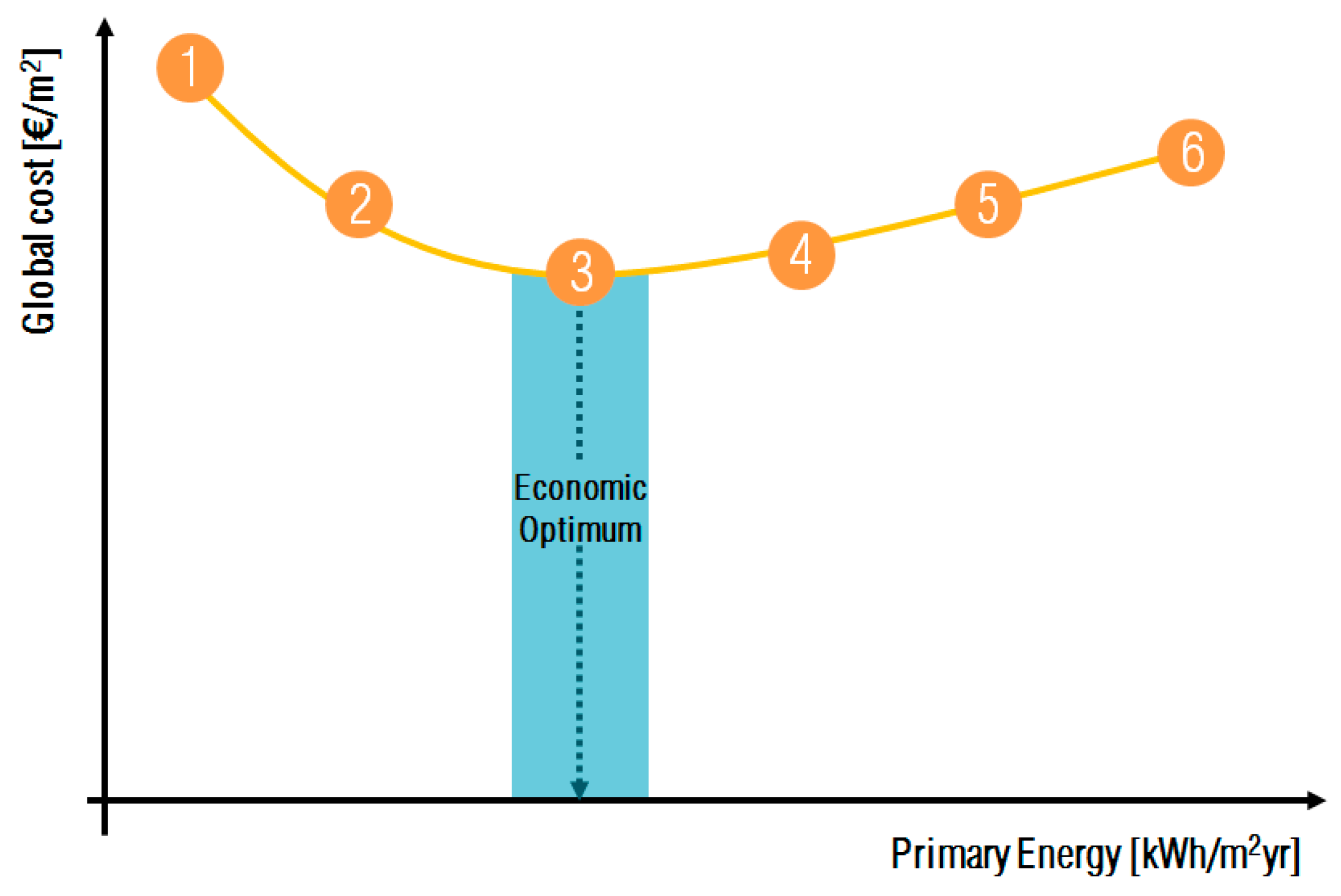
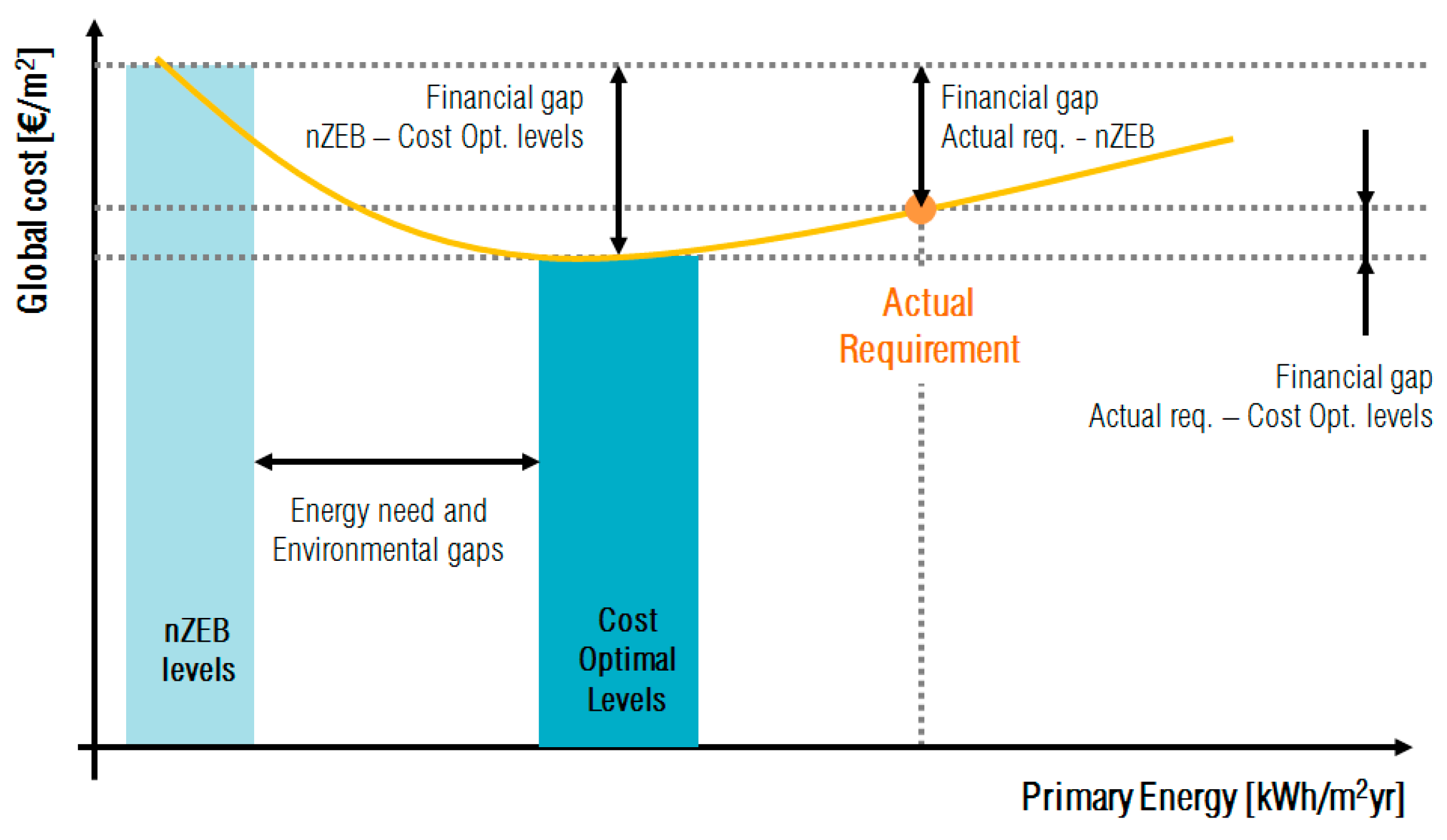
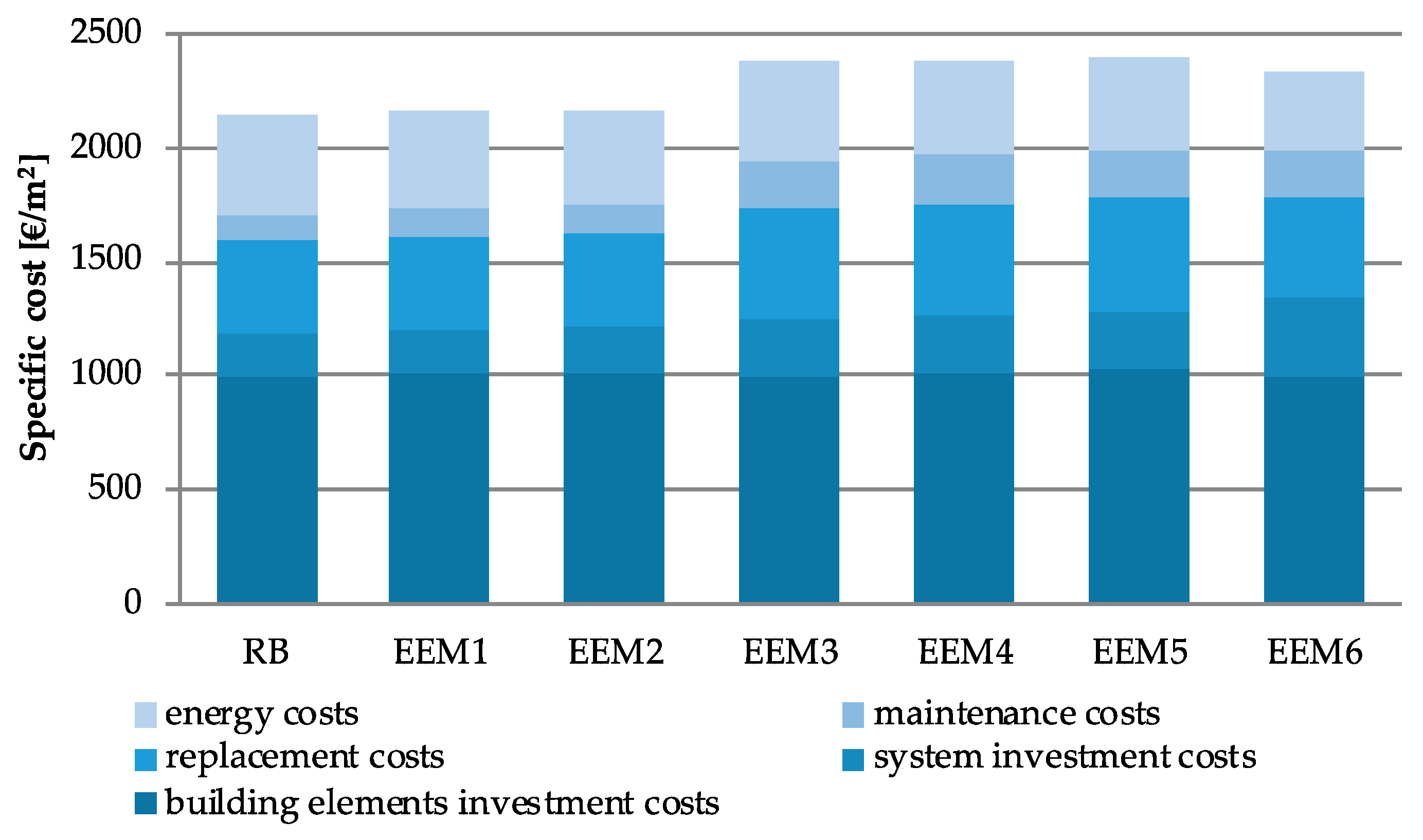
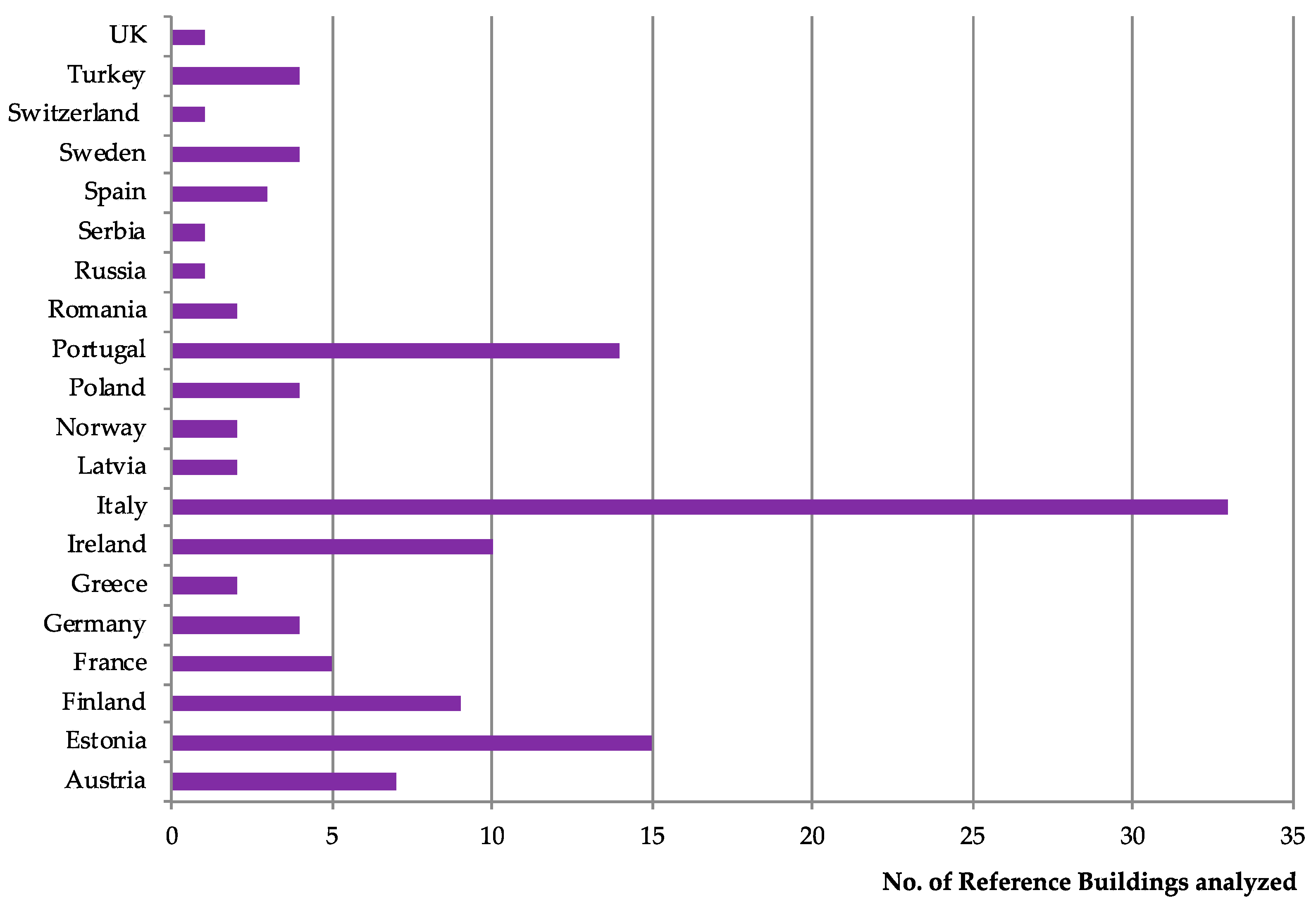

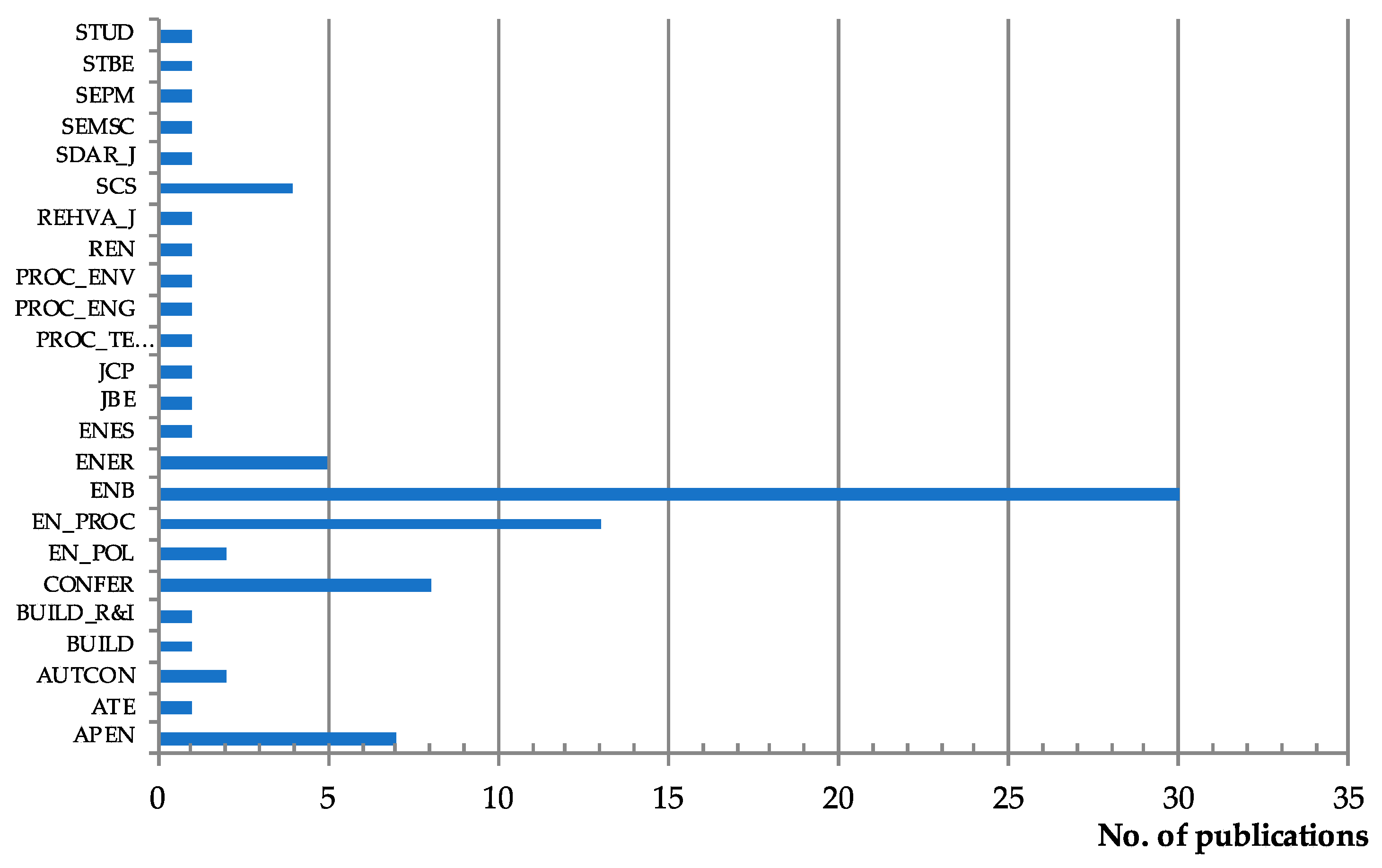
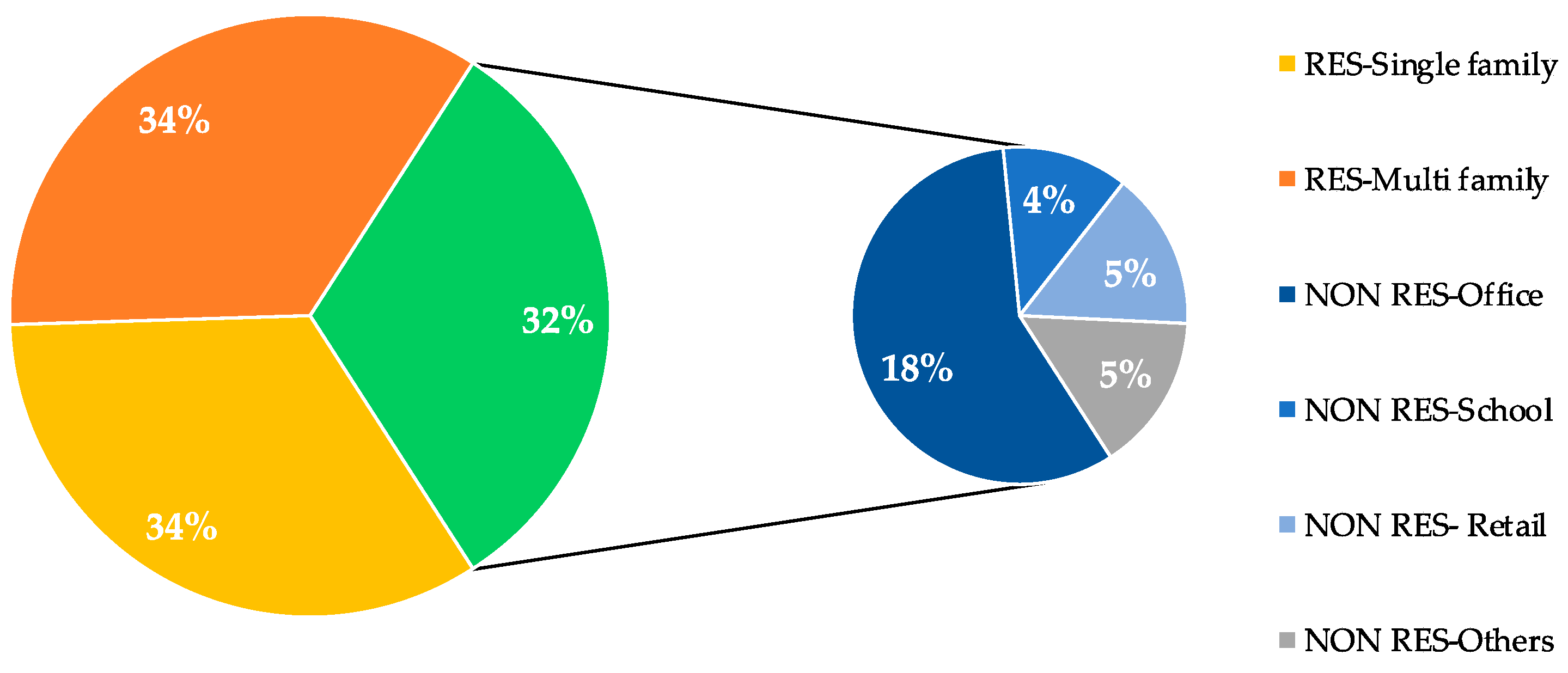


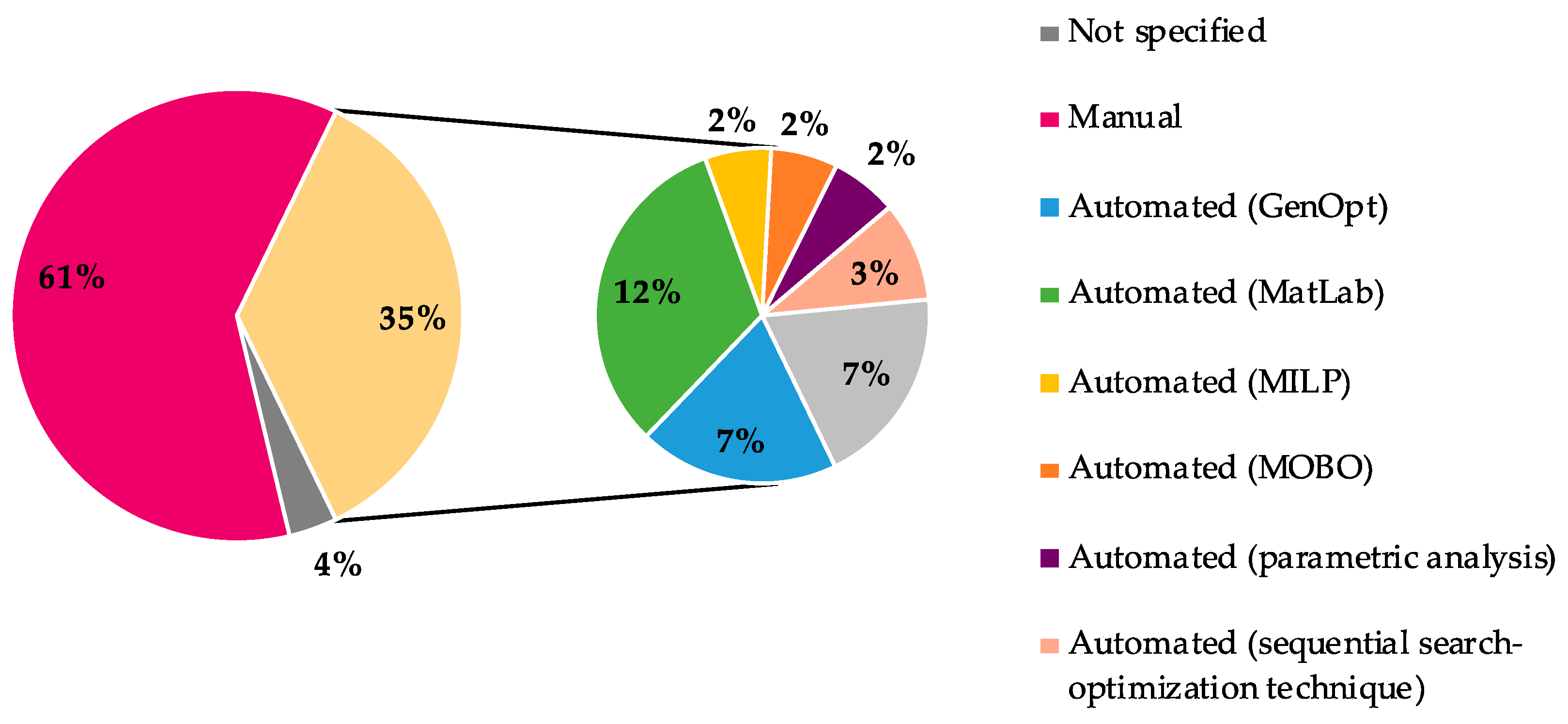
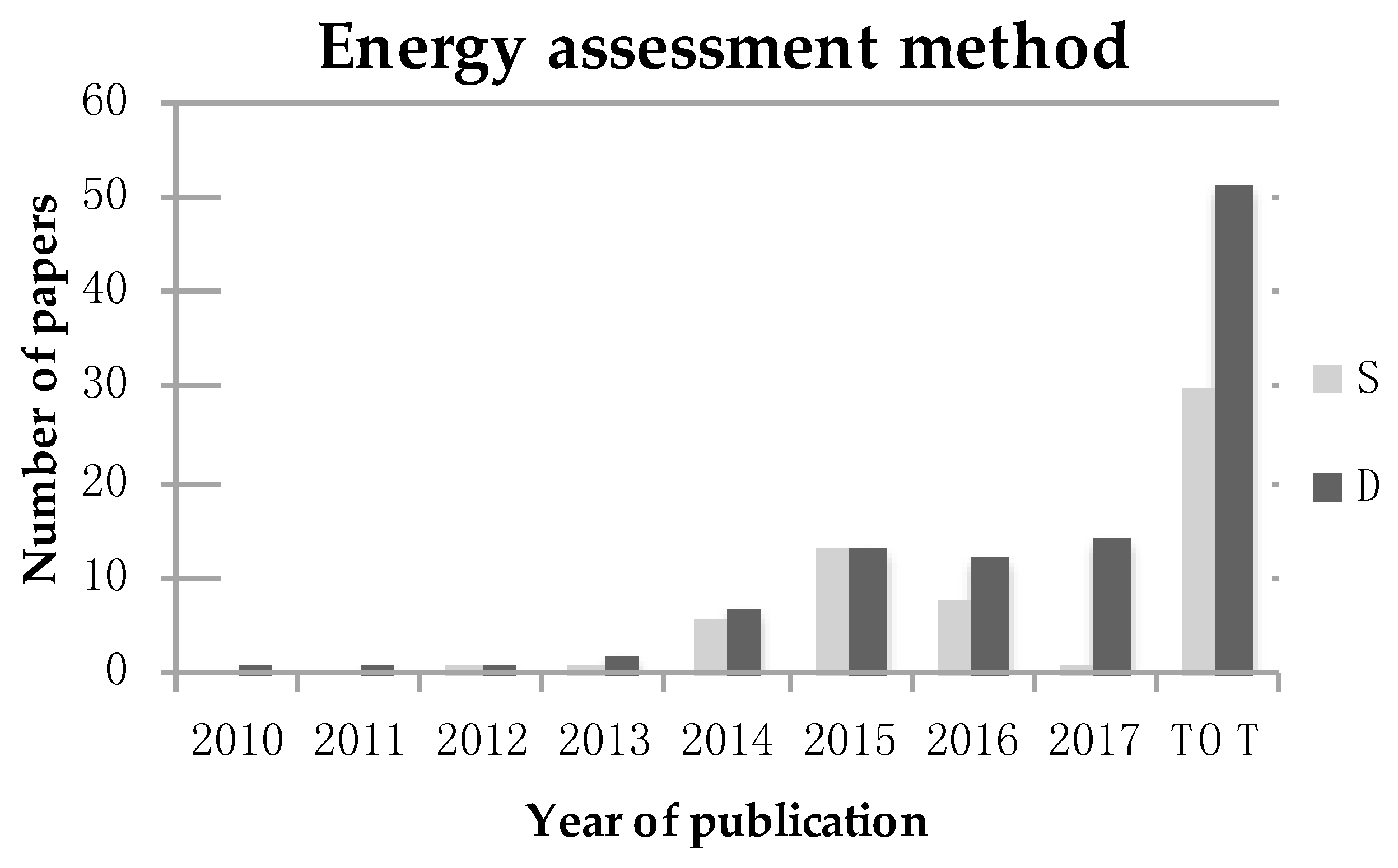
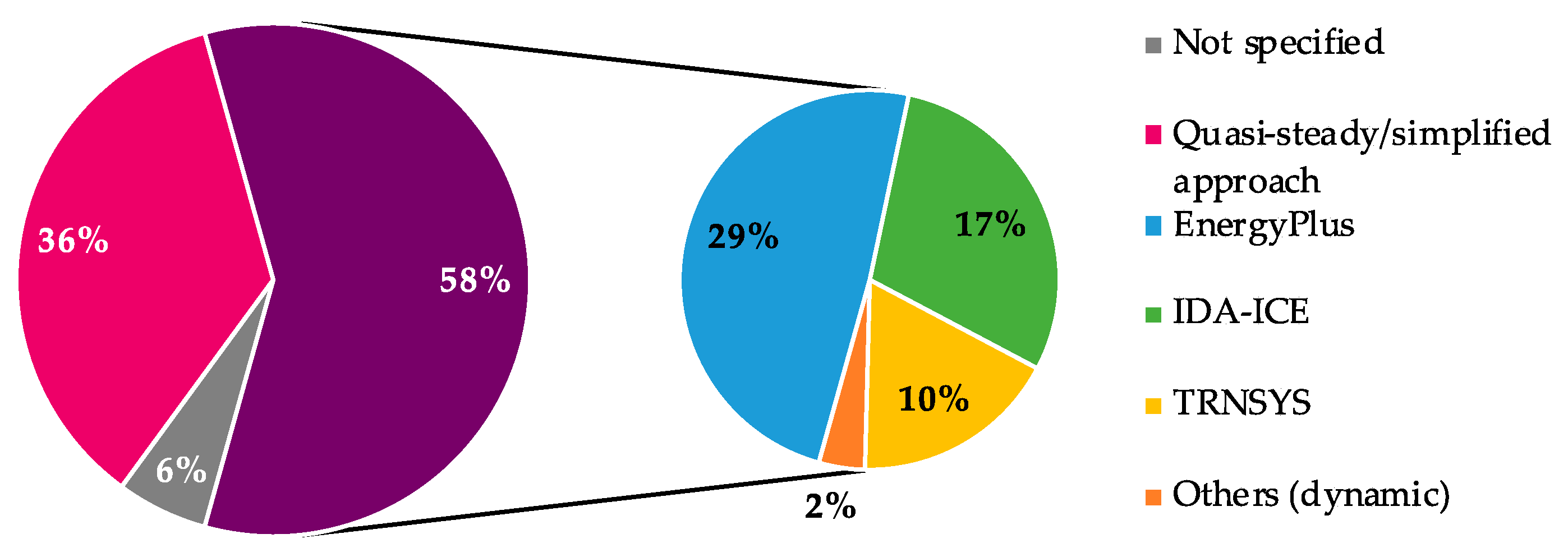

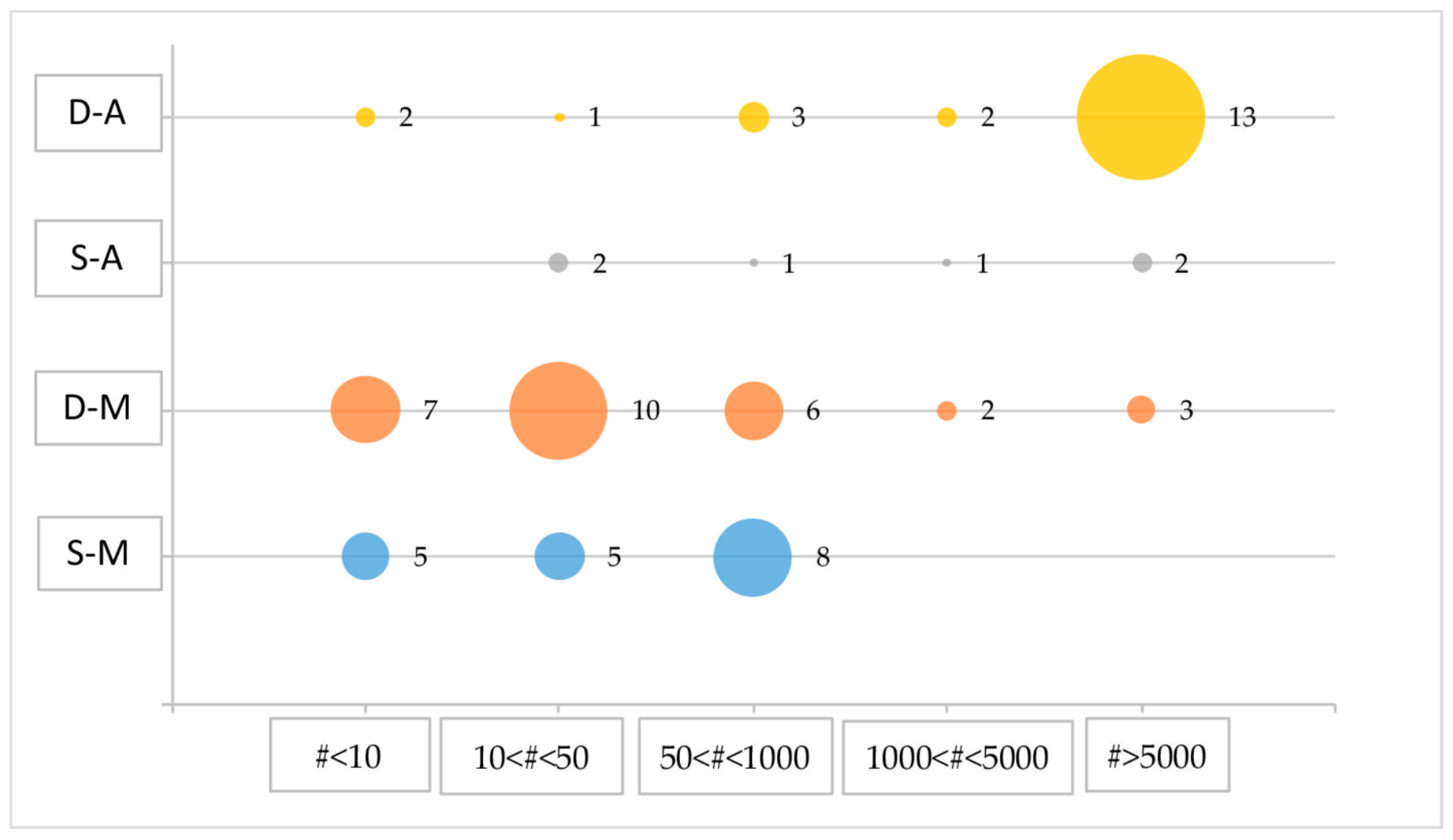
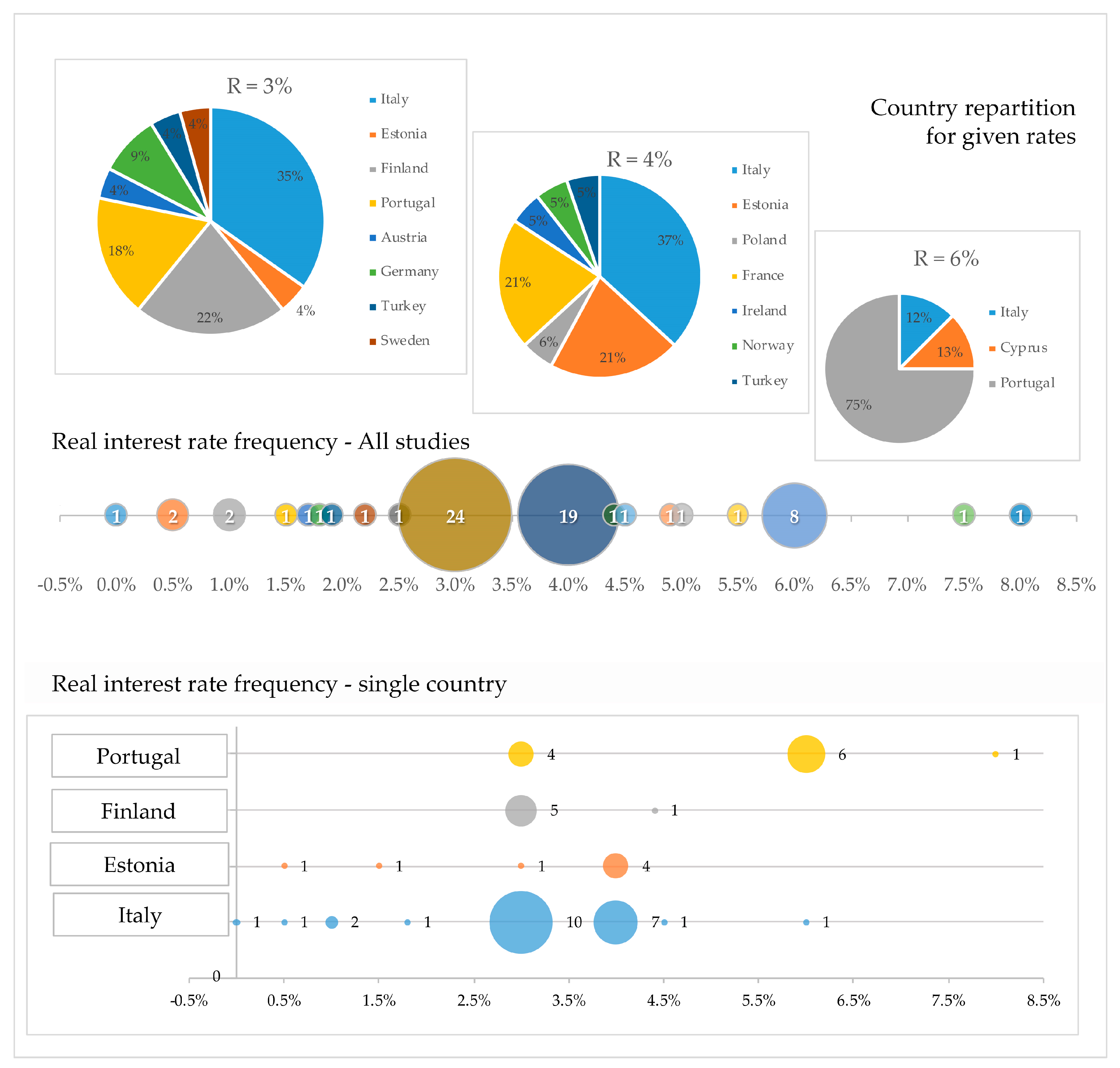
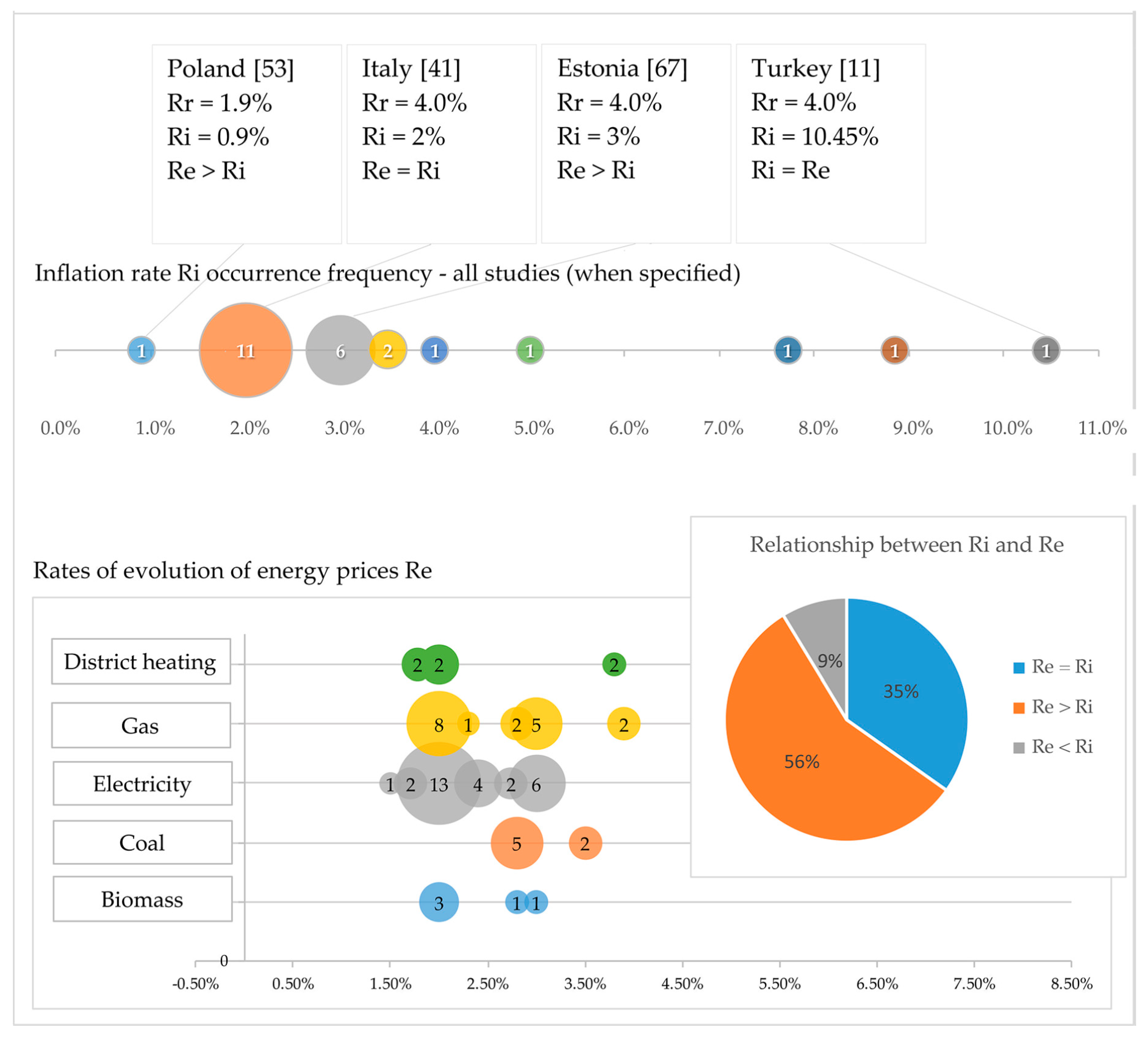
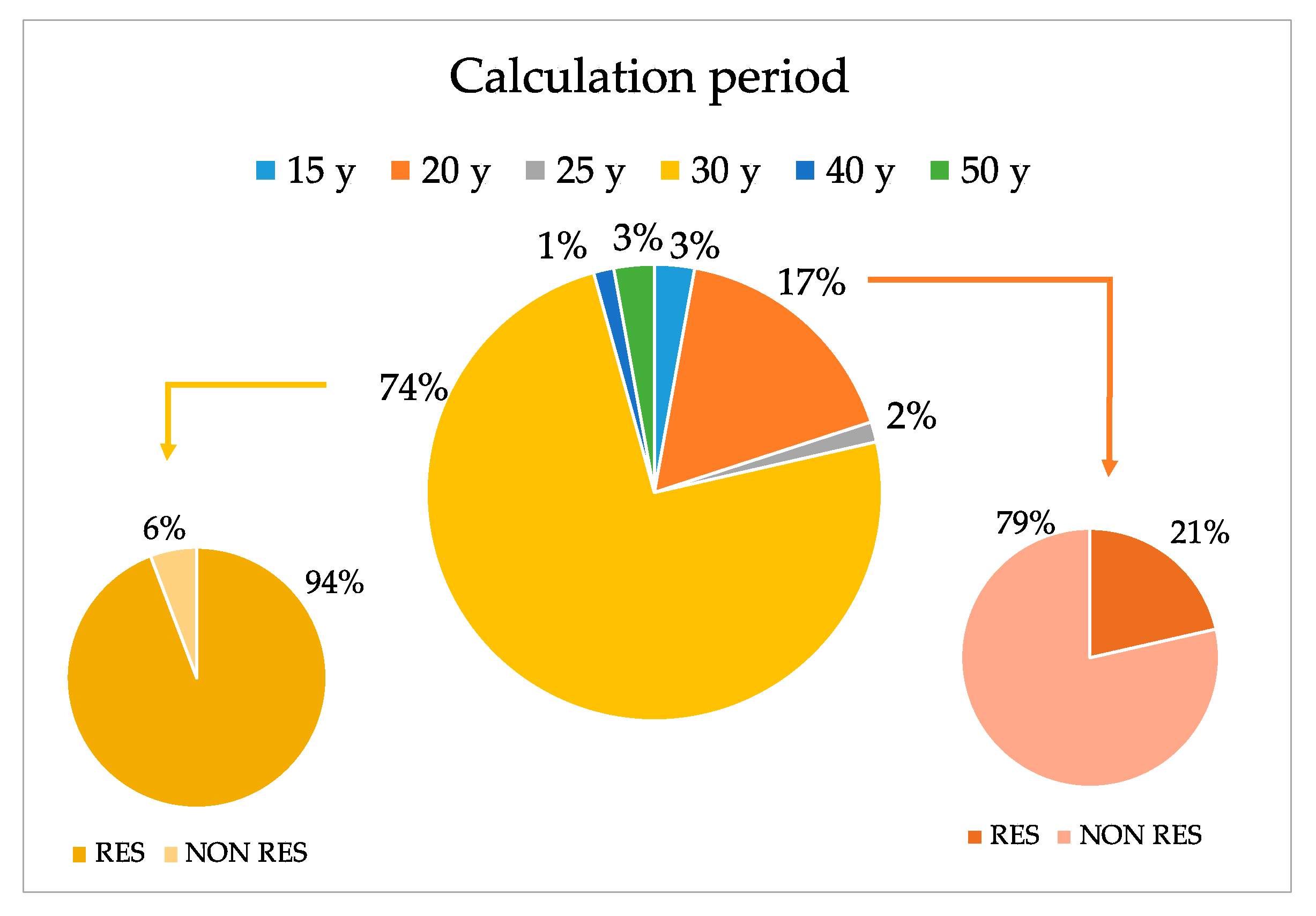

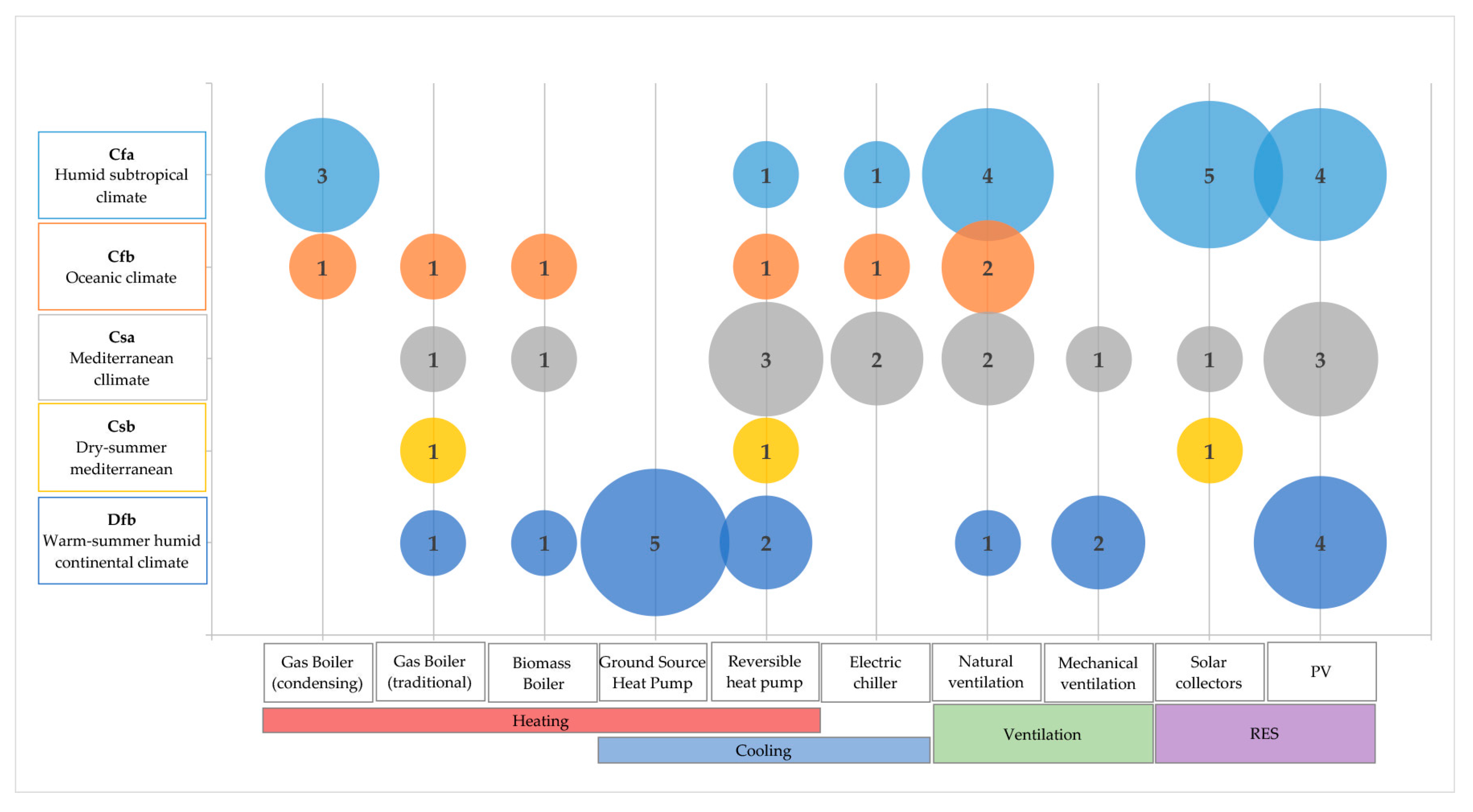
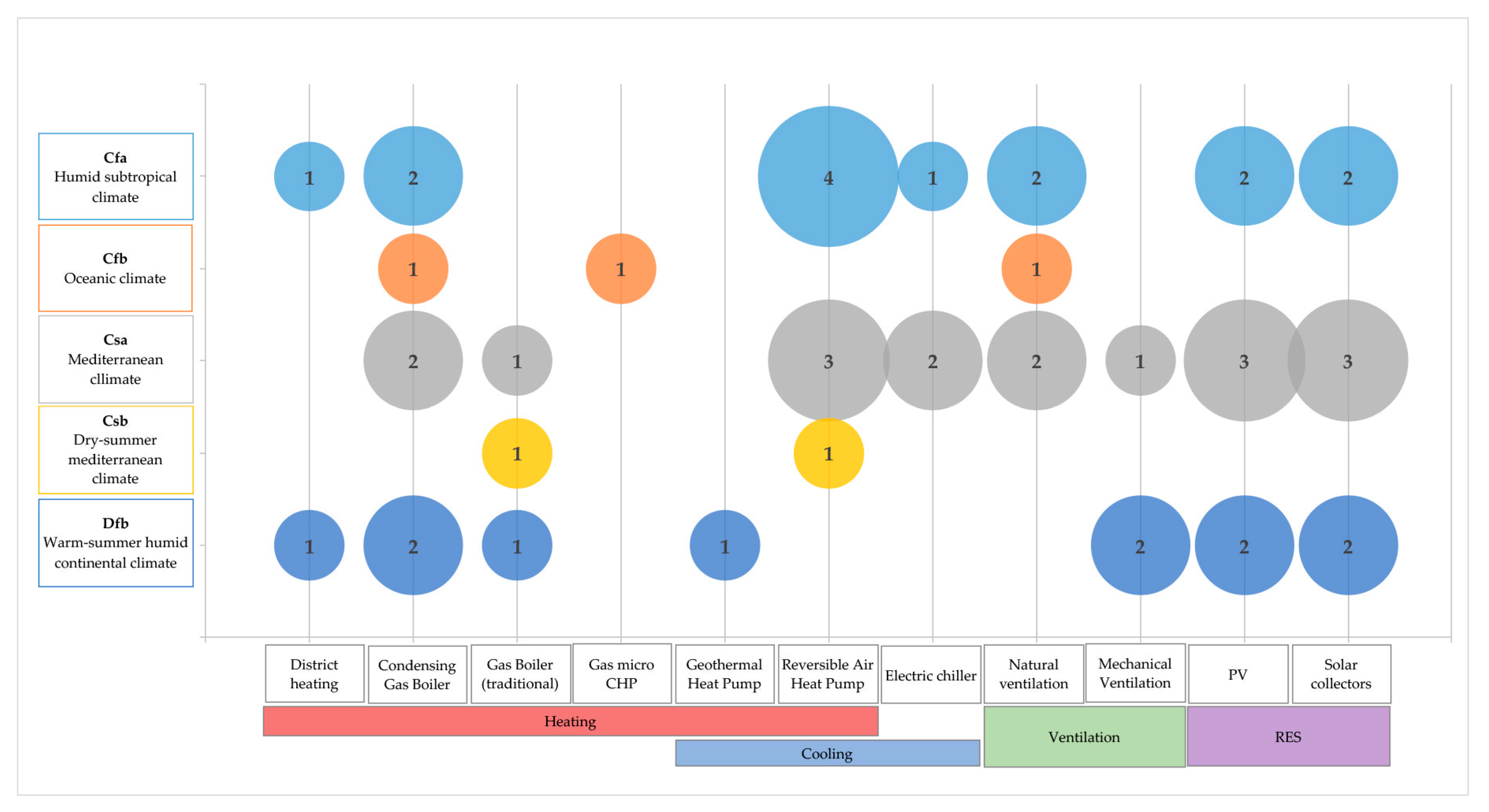
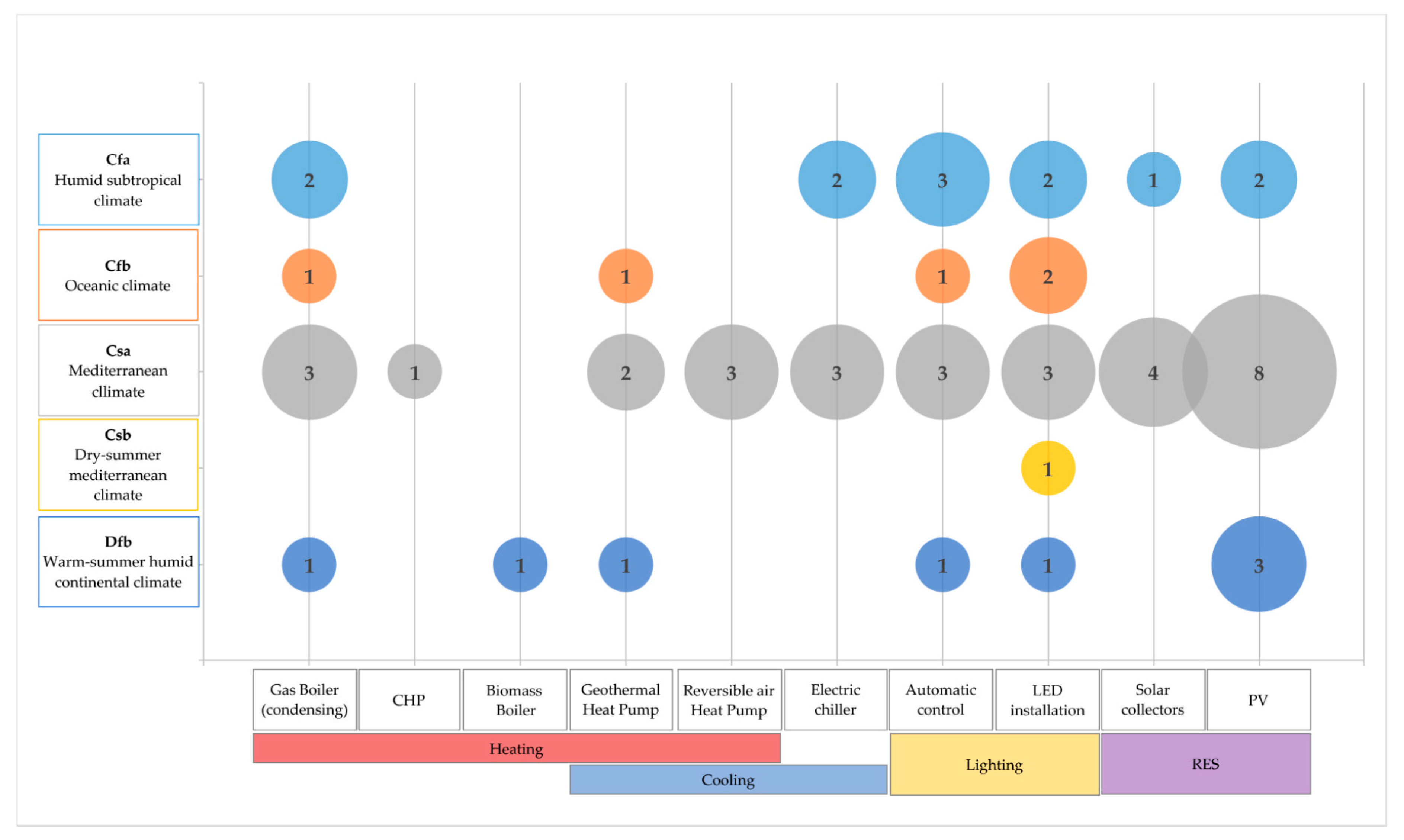
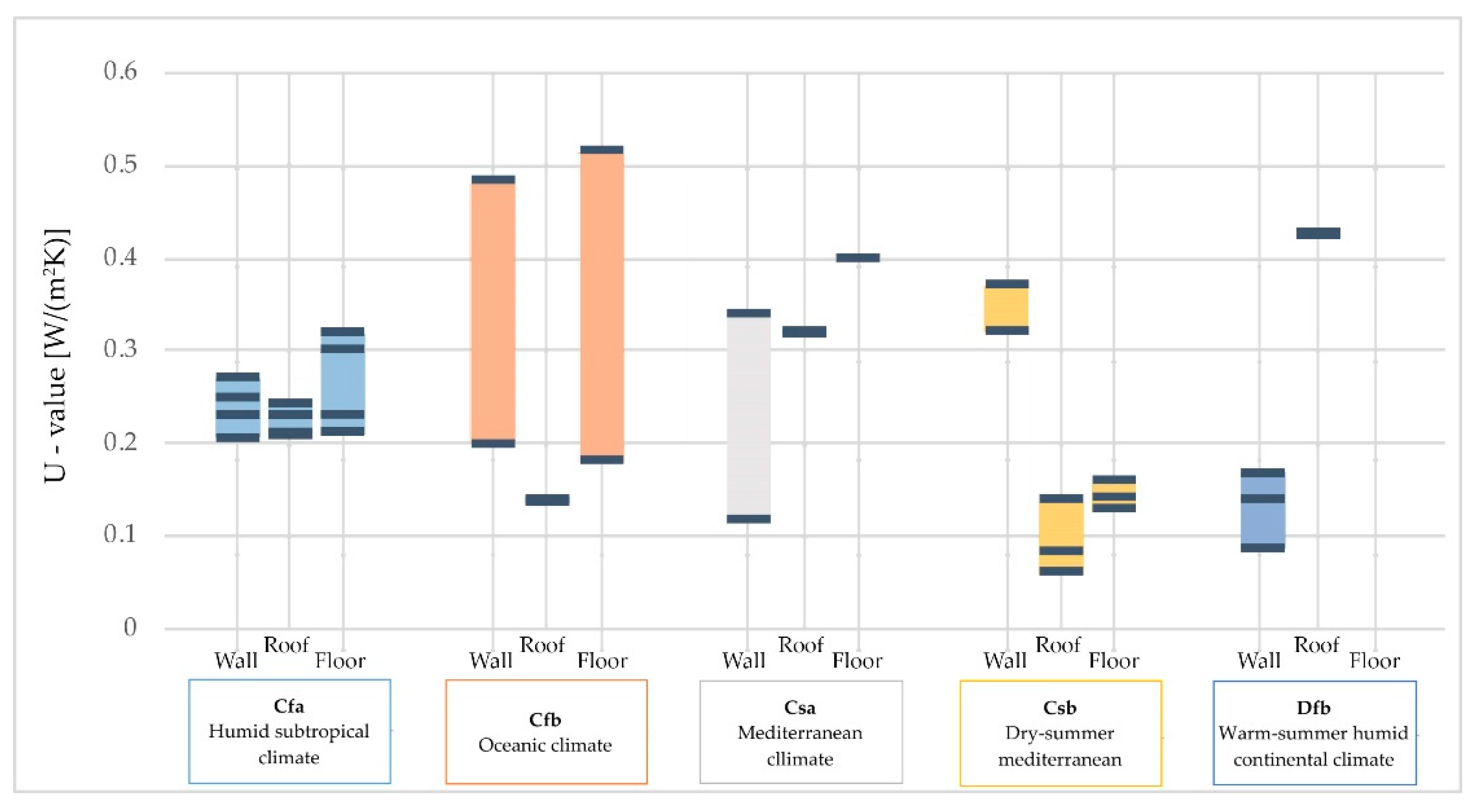

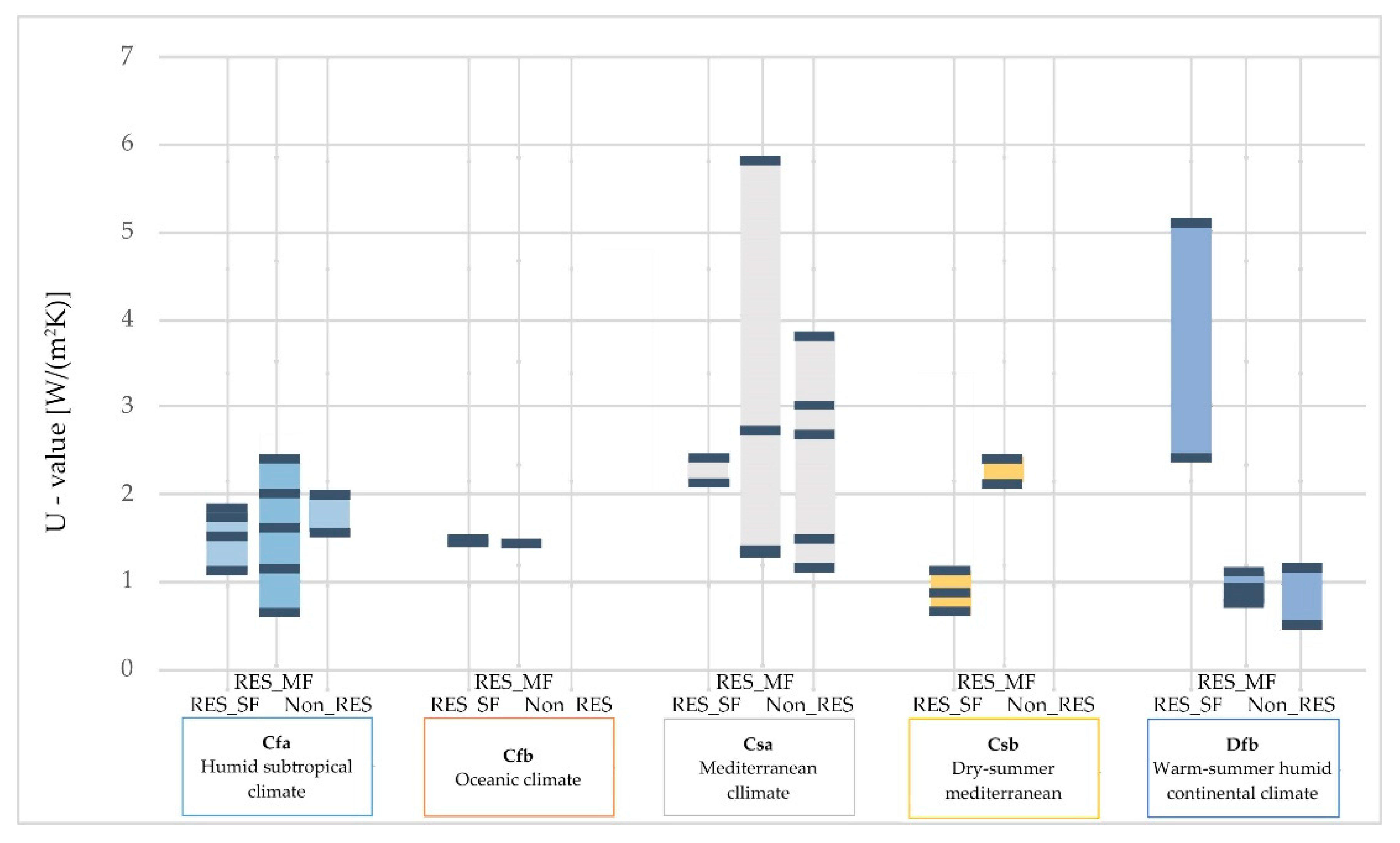
| Parameter | Financial Perspective | Macroeconomic Perspective |
|---|---|---|
| Interest rate | Real interest rate | Societal interest rate |
| Subsidies and incentives | Included | Excluded |
| Taxes | Included | Excluded |
| Cost of emissions | Excluded | Included |
| Reference | Authors | Year | Country | Building Type |
|---|---|---|---|---|
| [33] | A.Hasan | 2010 | Finland | RES_SF |
| [9] | J. Kurnitski, et al. | 2011 | Estonia | RES_SF |
| [34] | M. Hamdy, et al. | 2012 | Finland | RES_SF |
| [35] | M. Kapsalaki | 2012 | Sweden, Portugal, Greece | RES_SF |
| [13] | M. Hamdy, et al. | 2013 | Finland | RES_SF |
| [36] | J. Kwiatkowski, et al. | 2013 | Poland | RES_MF |
| [37] | M.J.N. Oliveira Panão, et al. | 2013 | Portugal | RES_MF |
| [38] | M. Thalfeldt, et al. | 2013 | Estonia, France | Office |
| [39] | E. Arumagi, et al. | 2014 | Estonia | RES_MF |
| [40] | N. Aste, et al. | 2014 | Italy | RES_MF |
| [14] | I. Ballarini, et al. | 2014 | Italy | RES_MF |
| [12] | V.M. Barthelmes, et al. | 2014 | Italy | RES_SF |
| [41] | C. Becchio, et al. | 2014 | Italy, Turkey | Office |
| [42] | E. De Angelis, et al. | 2014 | Italy | RES_MF |
| [16] | M. Ferrara, et al. | 2014 | France | RES_SF |
| [43] | M. Ferreira, et al. | 2014 | Portugal | RES_SF |
| [11] | N. Ganic, et al. | 2014 | Turkey | Office |
| [44] | A. Kamenders, et al. | 2014 | Latvia | RES_MF |
| [45] | J. Kurnitski, et al. | 2014 | Estonia | RES_SF/MF, Office, School |
| [10] | E. Pikas, et al. | 2014 | Estonia | Office |
| [46] | C. Pountney, et al. | 2014 | Ireland | RES_SF |
| [47] | L.C. Tagliabue, et al. | 2014 | Italy | RES_MF |
| [25] | G. Teodoriu, et al. | 2014 | Romania | RES_MF |
| [48] | L. Tronchin, et al. | 2014 | Italy | RES_SF |
| [49] | L. Aelenei, et al. | 2015 | Greece, Italy, Portugal, Romania, Spain | Office |
| [50] | M. Almeida, et al. | 2015 | Portugal | RES_MF |
| [15] | F. Ascione, et al. | 2015 | Italy | RES_MF |
| [51] | F. Ascione, et al. | 2015 | Italy | Office |
| [52] | F. Ascione, et al. | 2015 | Germany | Office |
| [53] | M. Basinska, et al. | 2015 | Poland | RES_SF/MF |
| [54] | M. Basinska, et al. | 2015 | Poland | RES_MF |
| [55] | C. Baglivo, et al. | 2015 | Italy | RES_SF |
| [17] | C. Becchio, et al. | 2015 | Italy | RES_SF |
| [56] | C. Becchio, et al. | 2015 | Italy | RES_SF |
| [57] | C. Becchio, et al. | 2015 | Italy | RES_MF |
| [58] | R. Bolliger, et al. | 2015 | Sweden, Switzerland | RES_SF |
| [59] | P.M. Congedo, et al. | 2015 | Italy | Office |
| [60] | V. Corrado, et al. | 2015 | Italy | RES_MF |
| [61] | S. Ferrari, et al. | 2015 | Italy | RES_SF |
| [62] | M. Haase, et al. | 2015 | Latvia, Norway, Spain, Russia, UK | Retail |
| [63] | A. Mohamed, et al. | 2015 | Finland | Office |
| [64] | V. Monetti, et al. | 2015 | Italy | RES_MF |
| [65] | G.M. Mauro, et al. | 2015 | Italy | Office |
| [66] | P. Penna, et al. | 2015 | Italy | RES_MF |
| [67] | E. Pikas, et al. | 2015 | Estonia | RES_MF |
| [68] | E. Pikas, et al. | 2015 | Estonia | RES_MF |
| [69] | D. Prando, et al. | 2015 | Italy | RES_MF |
| [70] | N.G. Saglam, et al. | 2015 | Turkey | RES_MF |
| [71] | E. Stocker, et al. | 2015 | Austria | School |
| [72] | S. Tadeu, et al. | 2015 | Portugal | RES_MF |
| [73] | Q. Wang, et al. | 2015 | Sweden | RES_SF |
| [74] | I. Zacà, et al. | 2015 | Italy | RES_MF |
| [75] | C. Araujo, et al. | 2016 | Portugal | RES_SF |
| [76] | F. Ascione, et al. | 2016 | Italy | Others |
| [77] | F. Ascione, et al. | 2016 | Italy | RES_MF |
| [78] | T. Ashrafian, et al. | 2016 | Turkey | RES_SF |
| [26] | A. Brandao de Vasconcelosa, et al. | 2016 | Portugal | RES_SF |
| [79] | A. Brandao de Vasconcelosa, et al. | 2016 | Portugal | RES_MF |
| [80] | P. Brinks, et al. | 2016 | Germany | Others |
| [81] | K.B. Lindberg, et al. | 2016 | Germany | RES_MF |
| [82] | S. Chardon, et al. | 2016 | France | RES_SF |
| [83] | P. M. Congedo, et al. | 2016 | Italy | School |
| [84] | V. Corrado, et al. | 2016 | Italy | RES_MF |
| [32] | M. Ferrara, et al. | 2016 | France | RES_SF |
| [85] | M. Ferreira, et al. | 2016 | Portugal | RES_MF |
| [86] | M. Ferreira, et al. | 2016 | Portugal | RES_SF, MF |
| [87] | K.B. Lindberg, et al. | 2016 | Norway | School |
| [88] | T. Niemela, et al. | 2016 | Finland | School |
| [89] | J. Ortiza, et al. | 2016 | Spain | RES_MF |
| [90] | S. Silva, et al. | 2016 | Portugal | RES_MF |
| [91] | S. Stevanovic, et al. | 2016 | Serbia | Office |
| [92] | S. Tadeu, et al. | 2016 | Portugal | RES_SF |
| [93] | D. Testi, et al. | 2016 | Italy | Others |
| [94] | F. Ascione, et al. | 2017 | Germany | Office |
| [95] | F. Ascione, et al. | 2017 | Italy | RES_SF |
| [96] | F. Ascione, et al. | 2017 | Italy | Others |
| [97] | F. Ascione, et al. | 2017 | Italy | RES_MF |
| [98] | F. Ascione, et al. | 2017 | Italy | Office |
| [99] | I. Ballarini, et al. | 2017 | Italy | RES_SF |
| [100] | M. Ferrara, et al. | 2017 | France | RES_SF |
| [101] | M. Hamdy, et al. | 2017 | Finland | RES_SF |
| [102] | S. Kumar Pal, et al. | 2017 | Finland | RES_SF |
| [103] | K. Loukaidou, et al. | 2017 | Cyprus | Others |
| [104] | T. Niemela, et al. | 2017 | Finland | RES_MF |
| [105] | T. Niemela, et al. | 2017 | Finland | RES_MF |
| [106] | N.G. Saglam, et al. | 2017 | Turkey | RES_MF |
| [107] | M. Thalfeldt, et al. | 2017 | Estonia | Office |
| [108] | J.C. Vallée, et al. | 2017 | France | RES_SF |
| EP Assessment | EEMs Selection | ||
|---|---|---|---|
| Manual (M) | Automated (A) | n/a | |
| Simplified method (S) | 21 | 9 | 1 |
| Dynamic calculation (D) | 29 | 22 | 0 |
| n/a | 3 | 0 | 2 |
© 2018 by the authors. Licensee MDPI, Basel, Switzerland. This article is an open access article distributed under the terms and conditions of the Creative Commons Attribution (CC BY) license (http://creativecommons.org/licenses/by/4.0/).
Share and Cite
Ferrara, M.; Monetti, V.; Fabrizio, E. Cost-Optimal Analysis for Nearly Zero Energy Buildings Design and Optimization: A Critical Review. Energies 2018, 11, 1478. https://doi.org/10.3390/en11061478
Ferrara M, Monetti V, Fabrizio E. Cost-Optimal Analysis for Nearly Zero Energy Buildings Design and Optimization: A Critical Review. Energies. 2018; 11(6):1478. https://doi.org/10.3390/en11061478
Chicago/Turabian StyleFerrara, Maria, Valentina Monetti, and Enrico Fabrizio. 2018. "Cost-Optimal Analysis for Nearly Zero Energy Buildings Design and Optimization: A Critical Review" Energies 11, no. 6: 1478. https://doi.org/10.3390/en11061478






